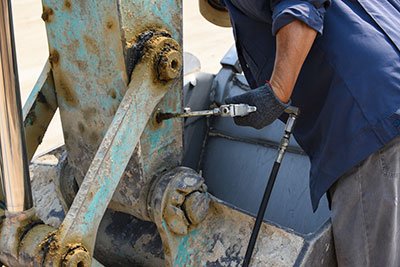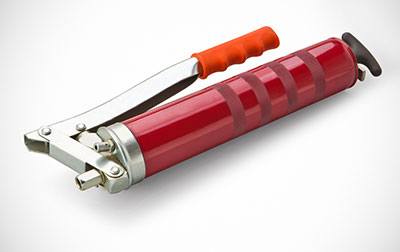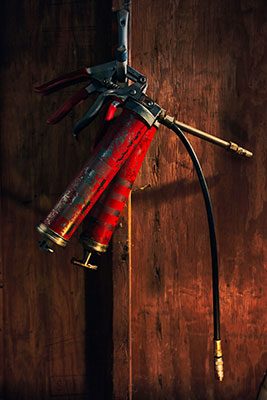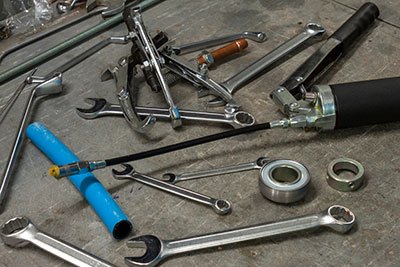Are you looking for a guide on how to utilize a grease gun and get the best performance out of it? If so, then this is the post for you!
We’ll show you how to keep your machines purring as they should be. Get ready to learn some important information about using a grease gun – let’s jump right in!
Take away key points:
- To use a grease gun properly, ensure safety standards to avoid injuries
- Pay attention to the sprung ball bearing, grease gun coupler, rod handle, plastic cap, plunger mechanism, and additional trigger mechanism in some models to ensure optimal performance of machines
- Follow the steps below and maintain your guns for the best use
Table of Contents
- Using grease guns properly: What you need to know!
- Frequently Asked Questions
- Do you push the rod in on a grease gun?
- Can you rent a grease gun?
- How do you completely clean a grease gun?
- How to reset a grease gun?
- How do I get my new grease gun to work?
- How do you fix an air grease gun?
- How do I get a stuck grease gun off my fitting?
- How do you grease trailer bearings with a grease gun?
- Conclusion
Using grease guns properly: What you need to know!
Refer to our comprehensive guide below to ensure the best use of your grease gun.
Find all crucial factors to consider, tips and tricks when utilizing it, and how to keep your overall performance optimal.
The step-by-step procedure when using a grease gun

Here are the basic steps you need to know when utilizing a grease gun properly:
Step 1: Remove the grease gun head from the barrel.
Step 2: Pull the rod handle back.
Step 3: Lock the rod handle.
Step 4: Open the new grease cartridge.
Step 5: Insert the new grease cartridge into the grease gun barrel.
Step 6: Note the pull tag on the end of the grease cartridge.
Step 7: Ensure the grease cartridge is sufficiently pushed to ensure the rim is connected with the rim of the grease gun.
Step 8: Reinstall the barrel to the grease gun end cap, yet keep it loose.
Step 9: Release the rod handle by turning it out of the retaining groove in the grease gun’s end cup.
Step 10: Depress the rod handle. Forcing the grease into the head of the grease gun to force grease and air pressure out.
Step 11: Pump grease out through the nozzle, and wipe it clean before attaching the nozzle to the grease gun.
Step 12: Tighten the grease gun end cap, pushing down on the air bleeder to ensure the rest of the air pressure comes out of the grease gun.
Step 13: Place the grease cup coupler at the end of the extension gun hose. Place it directly on the area necessary for greasing.
Step 14: Pump the lever handle multiple times (as much as necessary) to ensure the prep grease flow. You’ll ensure the grease gun works optimally for optimal uses.
How to use different types of grease guns?
As you already know, grease guns come in the following major categories:
- manual grease gun models (lever grease gun and pistol grip models)
- battery-operated grease gun models
- air-pressure grease gun (pneumatic grease gun models)
- AC electric grease gun models.
Below you can find how to properly use all these types of grease guns successfully.
1. Manual grease guns

Manual grease guns come in two popular models: lever grease guns and pistol-grip grease guns. Both the pistol grip grease gun and lever grease guns are known for being the most affordable types of grease guns.
Manual grease guns use pressures that can reach up to 10,000 pounds per square inch (psi). However, there are other different types of grease guns with higher pressure than manual grease gun models.
For those looking for higher pressure levels, plug-valve sealant guns provide up to 15,000 psi.
2. Battery-powered grease guns (cordless grease guns)
For those looking to speed up routine lubrication tasks and a smooth operation of the lubricant cartridge, a battery-powered grease gun is an ideal solution.
The processing systems also help reduce operator fatigue while being rated anywhere from 6,000 to 10,000 psi depending on the model and also reduce friction for proper grease gun usage.
3. Air-powered grease guns (pneumatic grease guns)
Air-powered models/Pneumatic grease guns are a simple and effective tool for dispensing lubricants under high pressure. By connecting to an air compressor, users can generate up to 6,000 psi of force with a variable-speed trigger for precise control of the air-powered/pneumatic grease gun.
This makes it easier to apply the right amount of lubricant in hard-to-reach areas or on heavy-duty industrial applications that require continuous operation. So, the air-powered/pneumatic grease guns work in such a way as to ensure the best grease fittings and other parts’ performance and ensure seamless operations.
The portability and ease of use of pneumatic grease guns make them ideal for automotive maintenance tasks such as greasing wheel bearings. No manual pumping or arm fatigue is required.
You can connect the pneumatic grease gun to a compressed air source and you’re ready to get the job done quickly and efficiently.
4. AC electric grease guns
The AC electric grease guns operate on offering a consistent flow of lubricants up to 7,000 psi. AC electric grease guns are an efficient alternative to pneumatic tools (air-powered tools.)
This makes the electric grease guns effectively used for heavy-duty industrial applications that require continuous running and intricate work such as greasing wheel bearings.
With these guns, you can find the right grease amounts in hard-to-reach places without having to worry about manual pumping or arm fatigue.
Their portability and ease of use make the electric grease guns ideal for automotive maintenance tasks. The user simply needs to plug them into an electrical outlet and they’re ready to go.
Thanks to their higher pressure rating compared to other tools, AC electric grease guns provide powerful performance without sacrificing accuracy.
So, you can use the power tools for consistent and steady pressure and force grease out of the grease tube easily. In addition, applying pressure will not create air pockets, and the grease will come out smoothly.
Using a grease gun properly: Training sessions
A variety of training is essential to effective lubrication, including applying the lubricant correctly and avoiding any potential damage due to misapplication, such as spills or harm to machinery.
An operator needs to be aware of which tools they need to use for the job, which pieces of equipment require lubrication, and how each grease gun functions. To ensure the safe application of lubricants, you should be paying attention to a few general rules:
- avoid contact with moving parts when applying the lube;
- keep proper footing and balance during the process to react quickly if needed;
- make sure that fits are located in accessible yet secure locations.
Proper user care

When using a grease gun, it is important to take certain safety precautions to avoid potential high-pressure injection injuries. All components must be rated for the amount of pressure being applied and hoses should be inspected before each use.
Any signs of wear or damage should be caused for replacement. The pull tab on grease cartridges should also be carefully removed to avoid getting cut by the tab’s sharp edges.
Additionally, the grease coupler should always be pointed away from the body when loading or priming the tool. The frozen fittings should never be lubricated for extended periods, as they may cake with mineral or vegetable oil.
If an injection injury is received, medical attention should immediately be sought and the type of lubricant used given to the technician, so that possible toxicity can be addressed.
When using a battery-operated grease gun, the power switch should always be in the off position before inserting the battery pack. It must be disconnected from the tool before changing accessories or unscrewing the cylinder. So you can load a grease gun or re-tighten the loose parts without excess air and pressure.
Care should also be taken not to expose the battery pack to water, nor should it come in contact with metal objects such as paper clips or coins. If the liquid from the battery comes into contact with skin or eyes, medical attention should be sought immediately.
When charging batteries or operating any electrical grease gun, ensure that it is used in a dry area. In addition, always follow the manufacturer’s instructions for operating, caring for, and servicing your tool.
Labeling your grease gun can also help identify which grease types are inside it. Cleaning grease fittings, grease nipples, a flexible hose, and a rigid nozzle is necessary for optimal grease gun uses.
The grease gun coupler should always be wiped before connecting them. Finally, wash your hands after you finish lubricating to remove chemical residue.
Cleaning & maintenance procedure
Proper cleaning and maintenance of grease guns are essential to ensure that they work effectively and last longer.
To maintain a clean grease gun, it should be hung horizontally inside a clean, fireproof cabinet, in a cool and dry environment. The plunger should be disengaged from the old grease tube.
It’s also important to wipe the grease fitting and grease nipple before use to clear debris. Inspect the grease fitting, rotary bearing, actuator assembly, and grease nipple for any damage or defects, and replace them if necessary.
Grease guns should also be cleaned regularly with water and an anti-grease mixture to remove any excess grease or residue. Additionally, the old grease cartridge should be removed from the gun and wiped down with a clean cloth. Finally, make sure to check all parts of the grease gun for debris or dirt buildup.
These steps will help keep your grease gun in tip-top condition and ensure that it works properly when needed. It’s also important to purchase quality parts for your grease guns such as couplers, hoses, grease nipples, and fittings from reputable retailers like Breed & Company or The Home Depot.
Safety tips & tricks for proper use

To ensure safety when using a grease gun, it is important to follow some basic safety tips and tricks.
First and foremost, always wear protective gear such as gloves and safety glasses when operating a grease gun. This will help protect against any potential injuries from the high pressure of the grease gun or any debris that may be present in the tool body.
Additionally, make sure to inspect the nozzle of the grease gun before use to make sure it is not blocked or damaged in any way. Pau attention when inserting a new lubricant cartridge into the tube to avoid injuries and pressure.
When attaching the nozzle to the grease fitting on a machine, take extra care to ensure that it is properly secured. If not done correctly, this could lead to an unexpected release of high-pressure grease which could cause serious injury. Since it requires a manual effort, take extra precautions.
It is also important to keep your hands away from the nozzle while operating the trigger mechanism of the grease gun as this could lead to an accidental injection of excess air and high-hand-pressure grease into your hand or arm.
Finally, always use a pressure relief valve when using a pneumatic or electric-powered grease gun. As they require the outlet nozzle and external devices, the guns can generate extremely high pressures which could cause serious injury if not properly regulated.
By following these simple safety tips and tricks when using a grease gun, you can help protect yourself and others from potential accidents and injuries caused by improper use of this powerful tool.
Frequently Asked Questions
Do you push the rod in on a grease gun?
Yes, you push the rod in on a grease gun. This is done by forcing air out of the chamber and pushing grease into it. This allows the piston to do its job of pushing grease down the hose and keeping the grease gun primed.
Additionally, some manual grease guns require a light push against the lubrication point to deliver small amounts of grease.
Can you rent a grease gun?
Yes, you can rent a grease gun. Many hardware stores and tool rental companies offer grease guns for rent. You may also be able to find a grease gun to rent online.
Read the rental agreement carefully before signing it so you know what is included in the rental and any additional fees that may apply.
How do you completely clean a grease gun?
To clean it, you can:
– Hang it horizontally inside a clean, fireproof cabinet with the plunger disengaged from the tube.
– Immerse a clean cloth in soapy water and squeeze out the excess water before using it to wipe down the grease gun.
– Use a mixture of water and an anti-grease solution for extra cleaning power. spray the grease gun with brake cleaner or pump enough new grease through to clear any remaining debris.
How to reset a grease gun?
Follow the steps below:
– Unscrew the end cap from the gun and remove the empty cartridge.
– Load a new grease cartridge into the gun.
– Prime the gun by locking out the follower rod, pushing against a hard surface, and giving the trigger several short pulls until grease appears at the nozzle.
– Bleed the system by loosening the screw on top of the pump and allowing it to cycle through its cycle.
How do I get my new grease gun to work?
Follow these steps:
– Attach the coupler to the end of the grease gun.
– Insert the tube of grease into the coupler.
– Pump the handle on the grease gun to push out the grease.
– Adjust the pressure release valve on top of your gun.
How do you fix an air grease gun?
The procedure is the following:
– Fill the reservoir with fresh grease.
– Ensure that all nipples are correctly sized and hardened for long life.
– Attach the hose to the gun and open up the valve on the end of it.
– Pump the handle several times until you see a steady stream of grease coming out of it.
– Close off the valve and check that there’s no more air in your system.
– Consider replacing some parts or investing in a new one altogether.
How do I get a stuck grease gun off my fitting?
The most common method is to use the pop-on fitting and try bending the hose gently to one side while turning it anticlockwise. This should be enough for it to pop off. If this doesn’t work, you can try grabbing the gun with pliers or wiping off any grease that may be preventing it from coming off.
Another option is to unscrew the hose or hard line from the grease gun, which will release the pressure and allow it to come off like normal. Finally, if your zerk fittings are clogged, you can apply some light pressure to the thumb lever with a pair of pliers and it should pop right off.
How do you grease trailer bearings with a grease gun?
Follow the steps below:
– Attach the grease gun to the grease fitting on the bearing.
– Release the plunger and push it down through the grease until it reaches the bottom of the gun.
– Twist the plunger-rod handle and release the spring.
– Tighten the tool and dispense grease onto a piece of cardboard until it flows freely from the nozzle.
– Push the nozzle against the tip of the bearing to lubricate it.
Conclusion
For the proper use of a grease gun, safety should be your main priority. Following these steps to ensure that the grease gun is used correctly can help to mitigate any mishaps from happening. It also extends the life of your machine.
Additionally, if you’re ever unsure as to how to utilize a grease gun, you can always get help from qualified professionals who can provide additional safety guidance.
